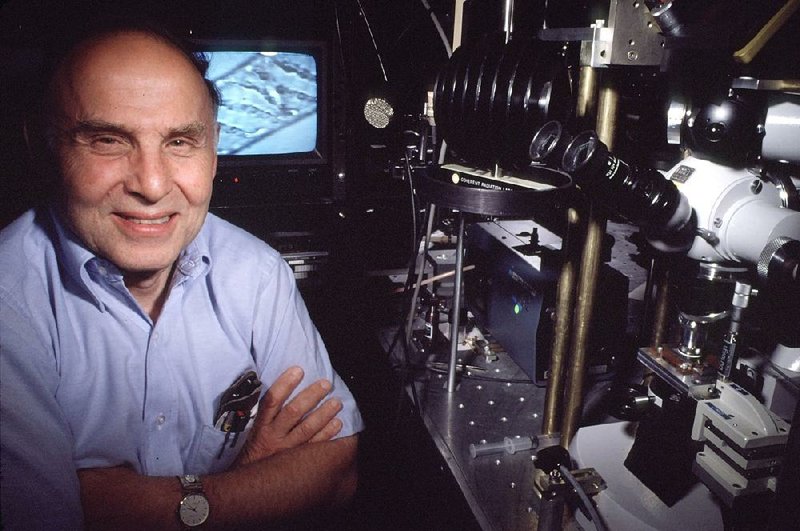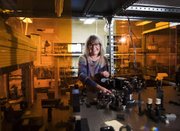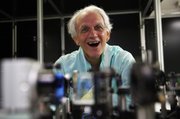NEW YORK -- Scientists from the United States, Canada and France won the Nobel Prize in physics Tuesday for revolutionizing the use of lasers in research, finding ways to make them deliver more powerful flashes of light and even to act like tiny tweezers.
Their work paved the way for laser eye surgery to improve vision and studies that can manipulate cells and their innards.
Two winners also made history for other reasons. Arthur Ashkin, the American who developed "optical tweezers," became the oldest Nobel Prize laureate at age 96. And Donna Strickland, of the University of Waterloo in Canada, became only the third woman to win the physics Nobel, and the first in 55 years.
Strickland and the third winner, Frenchman Gerard Mourou of the Ecole Polytechnique and University of Michigan, developed a way to generate high-intensity, ultra-short bursts of laser light. They share half of the $1.01 million prize while the other half goes to Ashkin, who worked at Bell Labs in New Jersey.
Ashkin said he was pleasantly surprised when he got the 5 a.m. call from Sweden.
"I'm very old and had given up worrying about things like Nobel Prizes," he said.
He said he's working on solar energy research at his New Jersey home. These days, though, scientific research is "a hobby more or less," he told the official website of the Nobel Prize.
"I tell my wife that's the only thing I'm really good at."
The work of the three winners constitutes "fundamental breakthroughs in physics that led to tools that are now being used all over science," said Robbert Dijkgraaf, director of the Institute for Advanced Study in Princeton, N.J.
Sweden's Royal Academy of Sciences said Ashkin's development of optical tweezers that can grab tiny particles such as viruses without damaging them realized "an old dream of science fiction," using the tiny amount of pressure exerted by beams of light to move objects.
That means lasers can be used to push, pull or hold in place tiny objects like atoms, molecules and living cells. Optical tweezers "created entirely new opportunities for observing and controlling the machinery of life," the Nobel committee said.
"You see the thing work and your heart stops. The hairs stand up on the back of your neck," said David Grier of New York University, who uses optical tweezers in his research.
With the ability to manipulate tiny cells like sperm and eggs, optical tweezers are used in research involving in vitro fertilization, Grier said. They can also be used to grab and stretch cells, and so distinguish between normal and cancerous cells, he said.
On an even smaller scale, they can be used to study how proteins interact with other molecules in the body, to unfold individual proteins and to study traits like how much torque they exert while rotating. And they can help give insights into how disease causes trouble by interfering with proteins that haul molecular cargo within a cell, said Arne Gennerich of the Albert Einstein College of Medicine in the Bronx.
Working together, Strickland and Mourou helped develop a way to produce very brief and intense laser pulses that have broad industrial and medical applications, including laser eye surgery and highly precise machine cutting. The academy said the two scientists' 1985 article on the technique was "revolutionary."
"With the technique we have developed, laser power has been increased about a million times, maybe even a billion," Mourou said in a video statement released by Ecole Polytechnique.
Strickland's award was the first Nobel Prize in physics to go to a woman since 1963, when it was won by Maria Goeppert-Mayer; the only other woman to win for physics was Marie Curie in 1903.
"Obviously, we need to celebrate women physicists because we're out there. And hopefully in time, it'll start to move forward at a faster rate," Strickland said in a phone call with the academy after the prize announcement.
Michael Moloney, chief executive of the American Institute of Physics, praised all the laureates.
"It is also a personal delight to see Dr. Strickland break the 55-year hiatus since a woman has been awarded a Nobel Prize in physics," Moloney said.
He credited the work of all three with "expanding what is possible at the extremes of time, space and forms of matter."
Information for this article was contributed by David Keyton, Samuel Petrequin, Frank Jordans and Bruce Shipkowski of The Associated Press.
A Section on 10/03/2018



